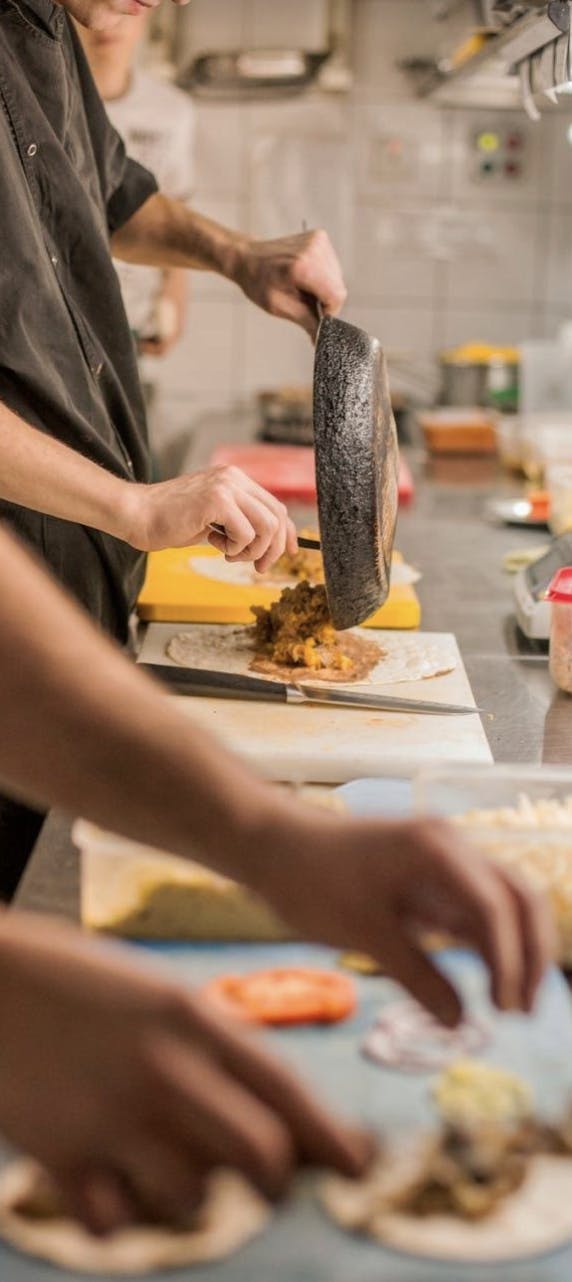Dynamic pricing for restaurants: boost profits with smart pricing strategies
Table of Contents
CloudKitchens
How many tacos can be delivered from a 1000sqft restaurant?
The same amount as a 200sqft ghost kitchen.
The restaurant industry is evolving rapidly, and pricing strategies must adapt to changing market conditions. Dynamic pricing for restaurants is a data-driven approach that allows restaurant owners to adjust menu prices in real time based on demand, time of day, customer behavior, and other factors.
This model, already widely used in industries like airlines and hotels, is now gaining traction in the food service sector. By implementing dynamic pricing, restaurants can maximize revenue, manage demand fluctuations, and enhance customer satisfaction.
Disclaimer: Some local, state, or national regulations may require price transparency or limit how and when prices can change. Restaurant owners should consult relevant laws or legal professionals to ensure their pricing strategies comply with applicable regulations.
Read More: Start a food delivery service: your complete how-to guide
What is dynamic pricing in restaurants?
Dynamic pricing, also known as surge pricing or demand-based pricing, is a strategy where menu prices fluctuate based on factors like:
- Time of day (higher prices during peak hours, discounts during off-peak times)
- Day of the week (weekend surcharges, weekday promotions)
- Customer demand (increased prices for high-demand menu items)
- External factors (weather conditions, local events, ingredient costs)
- Order method (different prices for delivery vs. dine-in orders)
By utilizing data analytics and AI-driven tools, restaurants can determine optimal pricing strategies to increase profitability while maintaining customer satisfaction.
Read more: Restaurant technology: Boost your business with the best technology trends
Benefits of dynamic pricing for restaurants
1. Maximizing revenue during peak hours
Restaurants often experience rush hours during lunch and dinner, while off-peak times may see significantly lower traffic. With dynamic pricing, restaurants can capitalize on peak hours by increasing prices slightly while offering discounts during slower periods to attract customers.
Example:
- A burger priced at $10 during lunch hour could be offered at $8 during mid-afternoon to boost sales.
2. Optimizing inventory and reducing waste
Food waste is a major concern in the restaurant industry. Dynamic pricing helps restaurants adjust prices based on inventory levels to move perishable items quickly and minimize food waste.
Example:
- If a restaurant has an excess of fresh seafood nearing expiration, it can offer a limited-time discount to encourage orders and reduce losses.
3. Encouraging off-peak orders
By offering lower prices during off-peak hours, restaurants can spread demand more evenly throughout the day. This prevents overwhelming kitchen staff during rush hours and improves overall efficiency.
Example:
- Happy Hour pricing from 3-5 PM on appetizers and beverages to increase mid-day traffic.
4. Enhancing customer experience with personalized pricing
Modern dynamic pricing tools use AI and data analytics to offer personalized discounts and promotions to repeat customers, increasing loyalty and retention.
Example:
- A loyal customer who frequently orders pizza might receive a special discount on their next order during a slow period.
5. Competing effectively with third-party delivery apps
With rising fees from food delivery platforms, restaurants can adjust delivery prices dynamically to cover costs without losing customers.
Example:
- Slightly increasing prices on third-party apps while offering exclusive in-house discounts to encourage direct ordering.
Read more: Mastering demand management: Strategies for handling peak delivery periods
How to implement dynamic pricing in your restaurant
1. Use data analytics to identify pricing opportunities
Start by analyzing past sales data, peak hours, customer preferences, and order trends. POS systems and restaurant management software can provide insights into when and how to adjust pricing.
2. Leverage AI-powered pricing tools
Modern restaurant pricing software, such as menu engineering tools or AI-driven platforms, can automatically adjust prices based on real-time demand.
Popular tools include:
- Woflow
- Toast POS
- Otter
3. Offer dynamic promotions and time-based discounts
Instead of just increasing prices, balance the strategy by offering discounts and special deals to encourage off-peak orders.
Examples:
- “Late-Night Cravings Deal” with discounted menu items after 9 PM.
- “Rainy Day Special” with discounted hot beverages on rainy days.
4. Educate customers about the pricing model
Transparency is key when implementing dynamic pricing. Communicate clearly that prices fluctuate based on demand and time of day to avoid customer frustration.
Example:
- Adding a disclaimer to your online menu: “Prices may vary based on demand and availability.”
5. Monitor performance and adjust strategies accordingly
Dynamic pricing isn’t a one-size-fits-all approach. Regularly analyze the impact of pricing changes and adjust strategies based on customer feedback and sales data.
Read more: Engaging local diners: A guide to restaurant geomarketing
Potential challenges and how to overcome them
While dynamic pricing offers many benefits, there are challenges that restaurant owners should consider:
1. Customer pushback
Some customers may be resistant to fluctuating prices, especially if they perceive them as unfair.
- Solution: Ensure transparency in pricing changes, communicate the benefits of dynamic pricing, and offer discounts to balance peak-hour price increases. Clearly explaining that discounts are available during off-peak times can help customers see the value in the model.
2. Technology costs
Implementing AI-driven pricing software may require an initial investment.
- Solution: Start with small-scale testing using manual price adjustments before investing in advanced tools. Research software options that offer scalable pricing structures and ensure that the return on investment (ROI) justifies the cost.
3. Competitive market dynamics
Competitors may not adopt dynamic pricing, making their static pricing appear more attractive.
- Solution: Focus on customer loyalty programs, personalized promotions, and exclusive offers to differentiate your brand. Highlighting the benefits of dynamic pricing, such as discounts during non-peak hours, can provide a competitive edge.
4. Regulatory and ethical concerns
Some regions may have regulations governing pricing transparency, and customers may view certain dynamic pricing strategies as unfair.
- Solution: Ensure compliance with local regulations and avoid extreme price fluctuations that may alienate customers. Clearly communicate how pricing changes work and offer value-driven promotions.
5. Maintaining customer trust
If customers feel they are being charged unfairly, it can hurt brand reputation.
- Solution: Build trust through transparency, loyalty rewards, and personalized discounts that show value rather than just price increases.
The future of dynamic pricing in the restaurant industry
As technology continues to advance, dynamic pricing for restaurants will become more sophisticated. AI-driven insights, real-time pricing updates, and automated decision-making will help restaurants remain competitive, maximize profits, and improve customer experiences.
Expect increased integration of machine learning algorithms that analyze historical and real-time data to predict demand fluctuations more accurately. Additionally, advancements in smart POS systems and digital menu boards will allow for seamless price adjustments without disrupting customer experience.
With the rise of personalized pricing models, restaurants can offer highly customized promotions based on individual customer behavior, further enhancing engagement and brand loyalty.
Read more: Transform your dark kitchen with smart online ordering solutions
Is dynamic pricing right for your restaurant?
Dynamic pricing is a powerful strategy that can boost revenue, optimize operations, and enhance customer satisfaction. By leveraging data-driven insights, restaurants can implement flexible pricing models that adapt to demand, inventory levels, and customer behavior.
If you’re looking for a smart way to manage pricing and maximize profits, consider integrating dynamic pricing into your restaurant’s business model. CloudKitchens offers solutions that streamline restaurant operations, enhance data analytics, and improve efficiency with the best ghost kitchens and additional services and technologies!
Learn how CloudKitchens can help optimize your restaurant’s pricing strategy and overall profitability by visiting CloudKitchens.
DISCLAIMER: This information is provided for general informational purposes only and the content does not constitute an endorsement. CloudKitchens does not warrant the accuracy or completeness of any information, text, images/graphics, links, or other content contained within the blog content. We recommend that you consult with financial, legal, and business professionals for advice specific to your situation.
More insights & stories
There’s more where that came from.
Get in the know and check out our additional insights


